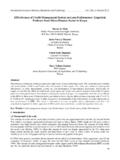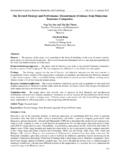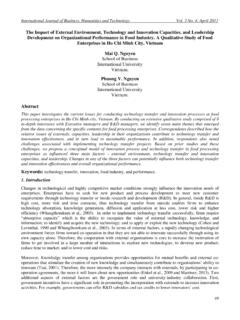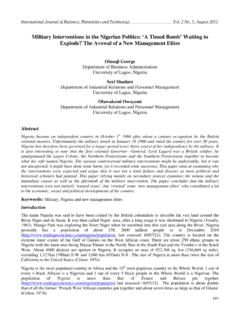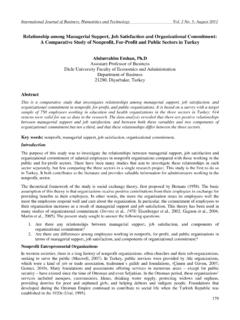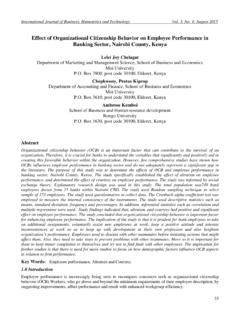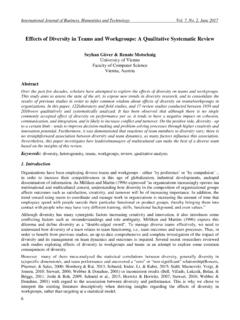Transcription of Organizational Culture and Organisational …
1 International Journal of Business, Humanities and Technology Vol. 3 No. 1; January 2013 95 Organizational Culture and Organisational performance : Empirical Evidence from the Banking Industry in Ghana Mariama Zakari, Kofi Poku Wilberforce Owusu-Ansah Department of Marketing and Corporate Strategy KNUST School of Business KNUST, Ghana. Abstract The relationship between Organisational Culture and performance has engaged the attention of researchers for many years. Majority of existing studies on Organisational Culture and performance have concentrated on developed countries. Using the Denison s Organisational Model, due to its integrative nature as well as its emphasis on both internal and external factors, this study examined the relationship between Organizational Culture and performance in Ghana, a developing country. All the variable items for Organisational Culture and performance were measured using five-point Likert scale and using the Denison s Organisational Survey Instruments.
2 The data was obtained from nine banks in Ghana constituting about 60% of the Banking Industry s Market Share, with different origins such as Public-Domestic, Private-Domestic, Pan African and Multinational Banks. The analysis was based on 296 respondents from various departments with varied positions. The study revealed that though there was significant differences among the banks in terms of the Organisational Culture Traits, there was no significant differences among them with regards to performance . Apparently, none of the banks is more innovative than the others. Overall, there was a positive relationship between Organisational Culture and performance in the Banking Industry in Ghana. In all cases, Mission was the Culture Trait with the strongest potential of impacting positively on performance . Key words: Banks, Organisational Culture traits, Involvement, Consistency, Adaptability, Mission, and performance Introduction Over the last two decades, there have been phenomenal changes in the nature of financial institutions in Africa, as a result of the entry of new aggressive competitors in the marketplace alongside the growing financial sophistication of customers and the greater and more efficient use of information technology (Rhine and Christen, 2008).
3 Until recently, banking in Ghana had suffered distress as a consequence of the pre-reform policies of financial repression, government control of banks and the prolonged economic crisis (Brownbridge and Gockel 1996). Freed from regulatory restraints, competitive pressures have intensified and weaker banks found themselves often unable to sustain their competitive market position. In order to sustain or gain competitive edge alongside superior performance , many organisations have restructured, merged, benchmarked, re-engineered, implemented total quality management programmes and introduced competitive staff benefits. Despite these attempts, organisations are yet to experience high performance (Davidson 2003). Peters and Waterman (1982) analysis of sustained superior financial performance of certain organisations have attributed their success to the specific Culture of each of the respective organisation.
4 Culture is often conceived as intangible, difficult to understand and worthy of focus only if there is time. However, the ability to identify the Culture traits of an organisation provides a platform for better understanding of the operations of the organisation for a better performance . Unfortunately, most often Organisational cultural issues are overlooked, while attention is directed towards activities that may have little or no positive effect on performance (Davidson 2003). Moreover, the quantitative studies that have been conducted on Organisational Culture have generally been performed in the developed countries and very little has been done in developing countries (Davidson, 2003) such as Ghana, especially in the banking industry. Centre for Promoting Ideas, USA 96 This study seeks to investigate the effect of Organisational Culture traits on performance in the banking industry in Ghana.
5 Contextualising the Organisational Culture Organisational Culture has been variously defined (Kroeber and Kluckhohn, 1963; O'Reilly and Chatman, 1996; Sudarsanam, 2010). This may be because of the ambiguous nature of the concept of the organisation (Schein, 1990) and the different understandings of what Culture is (Brown (1995). The Culture of an organisation can be defined as the embodiment of its collective systems, beliefs, norms, ideologies, myths and rituals. They can motivate people and can become valuable source of efficiency and effectiveness (Sudarsanam, 2010). A clear distinction can however, be made between those who think of Culture as a metaphor which allows for the understanding of organisations in terms of other complex entities such as the machine and the organism (Davidson, 2003) and those who think of Culture as an objective entity with personality (Van de Post et al, 1998).)
6 While there is no consensus on the components of Organisational Culture , most authors agree that it is: holistic, inter-subjective and emotional, rather than strictly rational (Christensen, and Gordon, 1999); historically determined and needs to be taught to new members as the correct way to perceive things (McGregor, 1960; Schein, 1990); related to anthropological concepts (McNamara, 2000); a collective phenomenon, socially constructed and shared by members of groups (Davis, 1984; Sergiovanni and Corbally, 1984); primarily ideational in character, having to do with meanings, understandings, beliefs, knowledge and other intangibles which govern peoples lives and behaviour patterns (Kennedy,1982, Kotter and Heskett, 1992; Pettigrew, 1979). It is difficult to change Culture since it forms the foundation for the organisation s management system (Ouchi (1981, Denison, 1990), provides meaning to the members of the organisation (Denison, 1990; Hofstede et al, 1990; Trice and Beyer, 1993) and outlasts Organizational products, services, founders and leadership and all other physical attributes of the organization (Schein (1992).))
7 Models of Organisational Culture Different models of Organisational Culture exist in literature. Famous among these models are schein (1992), Kotter and Heskett (1992), Hoftede et al (1990), Cameron and Quinn (1999), and Denison (1990). Schein (1992) argued that Culture exists at three successive levels. The most visible level of Culture is its artefacts and creations, consisting of its constructed physical and social environment. At the next level down are the values that drive behaviours. The third level consists of basic underlying assumptions which evolve as solution to problem. As it is repeated over and over again it is taken for granted. What was once a hypothesis, supported only by a hunch or a value, is gradually treated as a reality. Kotter and Heskett (1992) describe Culture as having two levels which differ in terms of their visibility and their resistance to change. At the deeper level, Culture refers to values that are shared by the people in a group and that persist over time even when the group membership changes.
8 At the more visible level, Culture embodies the behaviour patterns or style of an organisation that new employees are automatically encouraged to follow. Hofstede et al (1990) classify the manifestation of Culture into four categories, namely symbols, heroes, rituals and values. Symbols are words, gestures, pictures or objects that carry a particular meaning within a Culture . Heroes are persons, alive or dead, real or imaginary, who possess characteristics highly prized in the Culture and who thus serve as models for behaviour (Wilkins, 1984). Rituals are collective activities that are technically superfluous but are socially essential within a Culture , and can be considered to be carried out for their own sake. Hofstede (1980) describes these layers as being similar to the successive skins of an onion: from shallow superficial symbols to deeper rituals. Symbols, heroes and rituals can be subsumed under the term practices because they are visible to an observer, although their cultural meaning lies in the way they are perceived by insiders.
9 The core of Culture is formed by values, in the sense of broad, non-specific feelings of good and evil, beautiful and ugly, normal and abnormal, rational and irrational, that are often unconscious and rarely discussable. These values cannot be observed as such, but are manifested in alternatives of behaviour (Hofstede et al, 1990). Cameron and Quinn (1999) have developed an Organizational Culture framework built upon a theoretical model called the "Competing Values Framework." This framework refers to whether an organization has a predominant internal or external focus and whether it strives for flexibility and individuality or stability and control. The framework is also based on six Organizational Culture dimensions and four dominant Culture types ( , clan, adhocracy, market, and hierarchy). International Journal of Business, Humanities and Technology Vol. 3 No. 1; January 2013 97 The Denison s Model of Culture and Effectiveness (Denison, 1990) presents the interrelations of an organisation s Culture , its management practices, its performance and its effectiveness.
10 It highlights the importance of linking management practices with underlying assumptions and beliefs when studying Organisational Culture and effectiveness (figure 1 The Denison s Model of Culture The values and beliefs of an organisation give rise to a set of management practices, which are concrete activities usually rooted in the values of the organisation. These activities stem from and reinforce the dominant values and beliefs of the organisation. The model posits that there are four key cultural traits: involvement, consistency, adaptability and mission. Figure 1: Denison s Model of Culture and Effectiveness Source: Davidson (2003: p 49) Involvement Trait Involvement is the degree to which individuals at all levels of the organization are engaged in pursuit of the mission and work in a collaborative manner to fulfil Organizational objectives. This trait consists of building human capability, ownership and responsibility.)
